Oct 29, 2006
Fall Tracking
BRUCE TRAIL - off of Dunby Road
(HOCKLEY VALLEY PROVINCIAL NATURE RESERVE)
Meeting Report & Photos by Alexis Burnett
|
|
|
This late October morning brought sunshine, strong winds
and a couple inches of snow that had fallen overnight. It has been a wet
fall and the sun and glistening snow was a refreshing change.
Three others -- Alexa, Paul, Trudy and myself ventured out this blustery
fall day down the Bruce Trail and into the northern portion of the
Hockley Valley Nature Reserve. The cover of the coniferous trees
provided much needed shelter from the wind and provided us with many
tracks and 'mysteries' to uncover. |
|
|
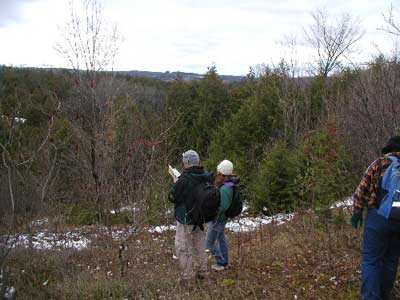 |
Shortly into our
walk we came upon a meadow with many Hawthorn trees in it.
Covered in ripe, red berries they are quite a food source to
many species of wildlife. We observed the differences between a
couple different species and talked briefly on some of the uses
of these shrubs. They continued to intrigue us throughout our
walk. Under the cover of the Red Pine
trees we also stopped to look at some deer tracks/trails as well
as some Red Squirrel 'digs'. We speculated on the habits and
caching abilities of these rodents at different times of year
and different food sources. As the day went on we began to look
at the ground on a ery detailed level. |
|
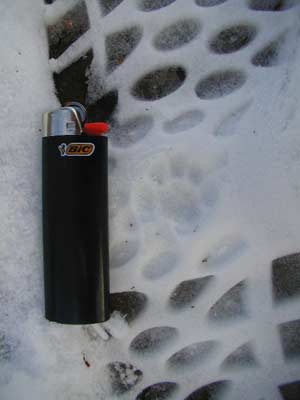 |
We found this track
moving down the center of the trail. It was less than an hour
old as it had stepped in the women's tracks who went down the
trail ahead of us. It was moving in a diagonal walk and the
tracks were three quarters of an inch length and width, roughly.
Some groups appeared to have four toes and some five? Do you
know what it was? It was tricky at the time, we all had our
opinions. |
|
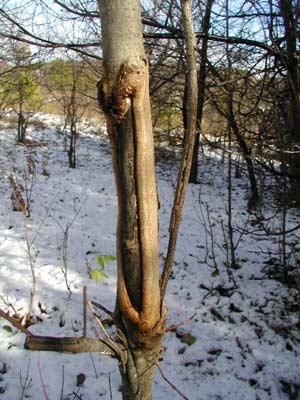 |
We also came upon
this old antler rub. This area on the edge of the forest showed
many signs of "feeding" activity by many animals including deer,
cottontails, red squirrel, coyote, etc... We talked of the
different browse signs left by different mammals and looked
closely at the ground looking for tracks. Paul found what looked
like a small red squirrel track in the middle of the trail among
many other compression shapes of various sizes. So much activity
in this area! |
|
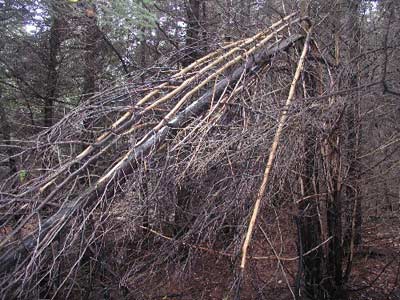 |
As we descended
into the lowland cedars we found this one that had had a lot of
its bark stripped by red squirrels. They strip this bark to line
their 'nests' for the winter. Upon close observation we could
see tiny four toed claw marks in the branches. |
|
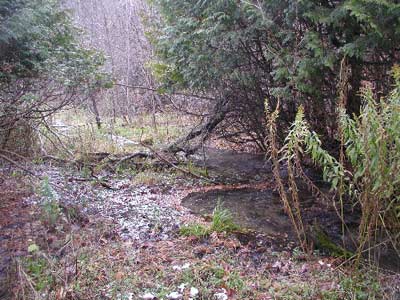 |
The ground was very
wet and 'springy' in this area, full of water after the fall
rains. Paul found a small deer antler from last year that showed
signs of rodents gnawing on it. We moved closer to the small
stream that had generated from many tiny springs in this area.
Fresh cold, clean water. Under one of
these magnificent cedars we found porcupine scats and saw
evidence of their claw marks on the trees. These trees have been
used by these animals for a very long time. |
|
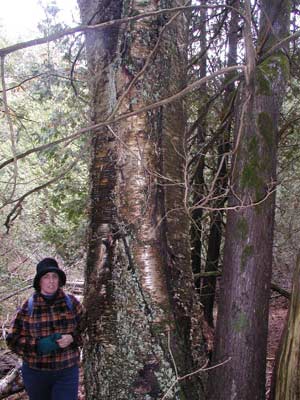 |
This was a big old
yellow birch that we came across beside the stream. This area
was full of some amazing old trees. Truly a very special place.
|
|
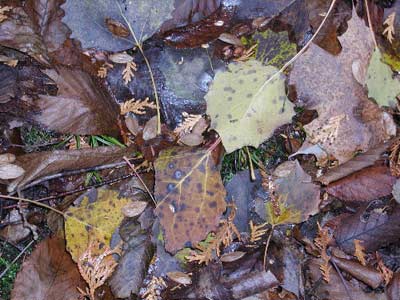 |
There were also
many small trees beginning their lives here. Many trees were
dropping seeds. Providing a huge food source for many species of
wildlife. Everywhere you looked on the forest floor was covered
in seeds. We spend some time examining
the Hop Hornbeam seeds and talking about their "techniques for
survival". |
|
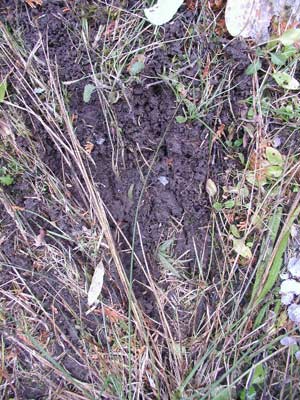 |
Along the stream
just out of the forest we found some wild mint and reveled in
the smell of this plant. We followed a deer trail up the other
side of the valley and came upon an area with a lot of
cottontail sign. On the deer trail we found this 'scrape'.
Upon closer investigation you could see claw
marks and toe pads. It was made by a canine. By the size it
seemed to be from a coyote. Have you seen wild canine's doing
this? What purposes do you think it serves? |
|
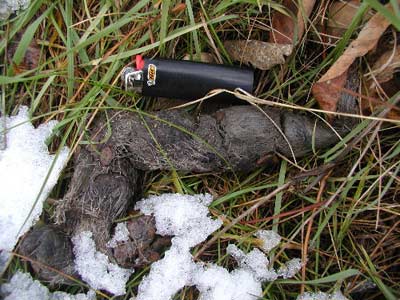 |
Later in the walk
we came upon 4-5 coyote scats of various sizes. One contained
strictly apples, while the others were full of deer hair. This
one was huge. It was found in a meadow along a deer trail. All
the others were placed on/beside deer trails as well. |
|
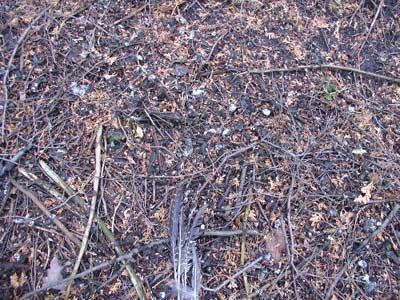 |
Under some large
hemlock and cedar trees we also found a favorite 'roosting' site
of the local wild turkey population. On the ground in the area
were many feathers and piles of scat. This area provided optimal
cover, especially from the west wind. It was very exciting to
run around collecting feathers and finding areas where these
large birds had spend many nights in these trees. |
|
We all had a great day in the forest and learned a lot from one
another. We moved at a slow pace and looked at things in detail. It was great to
spend the day with such inquisitive, curious and thankful individuals. I thank
everyone that made it out this day and look forward to seeing you again in the
future.
Happy Tracking
Alexis Burnett |
| |
| |